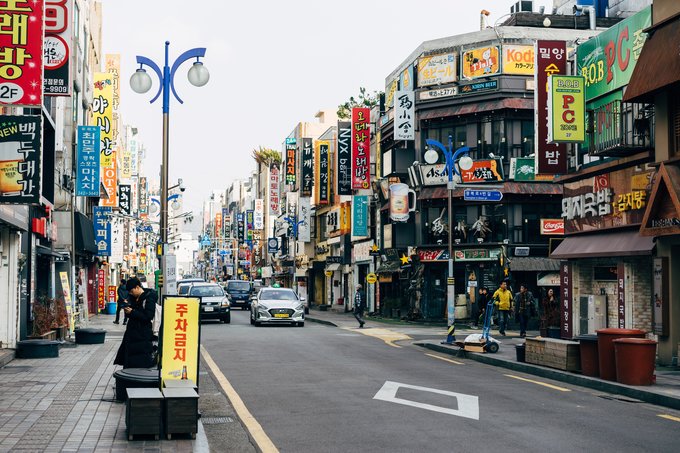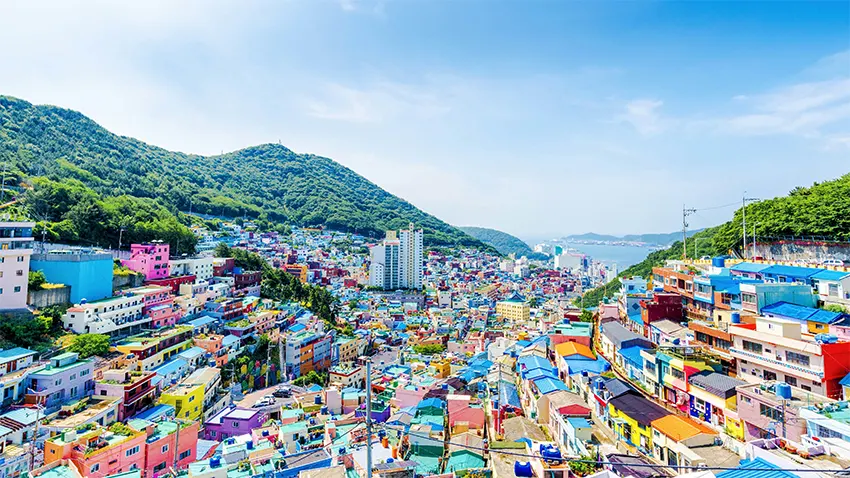Traveling to Busan (Pusan) is just as captivating and exciting as visiting Seoul, yet it rarely makes it onto most travel itineraries. With its sprawling coastline, mouthwatering fresh seafood, and vibrant cultural events, you’ll never find a dull moment here. For your upcoming trip to South Korea, why not head south and discover the wonders of Busan?
Busan serves as the economic, cultural, and educational hub of southeastern South Korea. Its port is the busiest in the country and ranks among the top nine busiest ports worldwide. The city is also famous for its colorful cultural happenings, such as the International Film Festival, the Haeundae Sand Festival, and the International Fireworks Festival.
Guide to Traveling in Busan (South Korea)
1. How to Get to Busan
1.1 Transportation Options to Busan
From Vietnam, direct flights to Busan are operated by Vietnam Airlines, Vietjet Air, Air Busan, Asiana Airlines, and Korean Air. Additionally, there are several ways to travel from Seoul to Busan:
By Plane: Five airlines regularly fly domestically from Gimpo (Seoul) to Busan: Korean Air, Asiana Airlines, Jeju Air, Air Busan, and Jin Air. Prices range from 100 to 150 USD for a round trip, depending on the date and any ongoing promotions. The flight takes about 55 minutes.
1.2 How Far is Busan from Seoul?
The distance between Seoul and Busan is approximately 325 kilometers. You can choose to travel by KTX train, plane, or long-distance bus.
KTX Train: This is South Korea’s high-speed rail system, reaching speeds of around 300 km/h with very few stops. There are about six daily trips from Seoul to Busan, with a travel time of roughly 2 hours and 40 minutes. Standard seat tickets cost 59,800 won per trip (about 48 USD), while first-class seats are 83,700 won (around 67 USD).
Regular Trains: Two options are available: ITX-Saemaul and Mugunghwa. The ITX takes 4 hours and 45 minutes, while the Mugunghwa takes 5 hours and 30 minutes. These trains move at a moderate pace, making them perfect for enjoying the scenery along the way. ITX tickets cost 42,600 won per trip (around 34 USD), and Mugunghwa tickets are 28,600 won (about 23 USD).
1.3 Getting from Gimhae Airport to Downtown Busan
Gimhae Airport is about 30 kilometers from the city center. Here are your options:
Taxi: A regular taxi can carry four passengers and four small suitcases. The fare is around 32,000 won (approximately 26 USD) for a 1-hour-20-minute ride.
Airport Limousine: This bus runs from Gimhae Airport to the Haeundae area, stopping near many hotels. It departs every 30 minutes, starting at 6:45 AM and ending at 9:55 PM. The trip takes about 50 minutes, costing 7,000 won for adults (around 6 USD) and 4,500 won for children (about 4 USD).
Metro: Take the Busan-Gimhae Light Rail from Airport Station to Daejeo Station (Line 3) or Sasang Station (Line 2), then transfer to Haeundae Station. The fare is 1,900 won (about 1.50 USD) for a 1-hour-20-minute journey.
1.4 Getting Around Busan
The metro is the most convenient way to explore Busan. It’s modern, clean, punctual, affordable, and covers a wide network. Busan’s metro system includes six lines:
- Line 1 (Red): Nopo to Dadaepo Beach
- Line 2 (Green): Yangsan to Jangsan
- Line 3 (Brown): Daejeo to Suyeong
- Line 4 (Dark Blue): Anpyeong to Minam
- Busan-Gimhae LRT (Purple): Kaya University to Sasang
- Donghae Line (Light Blue): Ilgwang to Bujeon
If you plan to move around a lot, consider getting a T-money card. Widely used across South Korea, it’s especially handy for public transportation and comes with various discounts. Here’s the metro fare breakdown in Busan:
| Category | T-money Card Fare | Single-Trip Ticket Fare |
|---|---|---|
| Adults (19+) | Section 1: 1,300 won (~1 USD) Section 2: 1,500 won (~1.20 USD) |
Section 1: 1,400 won (~1.10 USD) Section 2: 1,600 won (~1.30 USD) |
| Teens (13–18) | Section 1: 1,050 won (~0.85 USD) Section 2: 1,200 won (~1 USD) |
Section 1: 1,150 won (~0.90 USD) Section 2: 1,300 won (~1 USD) |
| Children (7–12) | Section 1: 650 won (~0.50 USD) Section 2: 750 won (~0.60 USD) |
Section 1: 700 won (~0.55 USD) Section 2: 800 won (~0.65 USD) |
Note: Section 1 covers distances under 10.5 km, while Section 2 is for distances over 10.5 km.
Tourist Attractions in Busan
1. Haeundae Beach – Busan
Address: 1015 Haeundae, Jung 1(il)-dong, Busan
Entrance Fee: Free
Hours: Open daily
How to Get There: Take Metro Line 2 to Haeundae Station, exit 3 or 5, then walk about 10 minutes.
Haeundae is Busan’s most famous beach. Its picturesque shoreline and expansive horizon create a breathtaking scene. In summer, the beach buzzes with crowds and endless rows of colorful umbrellas. Every May, it hosts a sand sculpture festival that draws visitors from far and wide.
2. Igidae Coastline
Address: 105-20 Igidaegongwon-ro, Yongho sam-dong, Nam-gu, Busan
Entrance Fee: Free
Hours: Open daily
How to Get There: Take Metro Line 2 to Kyungsung University/Pukyong National University Station, exit 3 or 5, then transfer to bus 20, 22, or 131 to Igidae National Park.
This 4-kilometer trail winds along coastal cliffs and takes about 2.5 hours to complete. Along the way, you’ll encounter stunning sights like sea caves, dinosaur footprints, and some of Busan’s most iconic landmarks, including Haeundae Beach, Gwangan Bridge, and Dongbaekseom Island across the water. The trail ends at the Oryukdo Skywalk, a glass-bottom bridge offering jaw-dropping views of the sea below.
3. Haedong Yonggungsa Temple
Address: 86 Yonggung-gil, Gijang-eup, Gijang-gun, Busan
Entrance Fee: Free
Hours: 4:00 AM – 7:00 PM daily
How to Get There: From Haeundae Station, exit 7, take bus 181 or 100 to Yonggungsa Temple stop. Bus fare is 1,200 won (~1 USD). A taxi costs around 10,000 won (~8 USD) one way.
Unlike most Korean temples tucked away in the mountains, Haedong Yonggungsa, built in 1376, sits perched on seaside cliffs. The sound of crashing waves blends with the temple’s serene atmosphere, creating a harmonious escape. With its tranquil grounds and spacious courtyards, it’s an ideal spot for reflection and peace. It’s also one of the best places in Busan to catch a sunrise.
4. Yongdusan Park – Busan
Address: 37-55 Yongdusan-gil, Gwangbok-dong, Jung-gu, Busan
Entrance Fee: Park: Free; Busan Tower: 5,000 won (~4 USD)
Hours: Park: April–September (8:30 AM – 10:00 PM), October–March (9:00 AM – 10:00 PM); Busan Tower: 9:00 AM – 10:00 PM
How to Get There: Take Metro Line 1 to Nampo Station, exit 1, 3, or 7, then walk 10 minutes.
Located in the heart of the city on a mountain of the same name, Yongdusan translates to “Dragon Head Mountain” due to its dragon-like shape. The park’s standout feature is the nearly 120-meter-high Busan Tower, a perfect vantage point for soaking in panoramic views of central Busan.
5. Taejongdae Park – Self-Guided Busan Travel
Address: 24 Jeonmang-ro, Dongsam 2(i)-dong, Yeongdo-gu, Busan
Entrance Fee: Free
Hours: October–April (9:00 AM – 5:00 PM), May–September (9:00 AM – 6:00 PM); last entry 30 minutes before closing
How to Get There: Take Metro Line 1 to Nampo Station, exit 6, then take bus 66, 88, or 101 to the final stop (about 60 minutes).
Note: If walking isn’t your thing, hop on the Danubi train that circles the park for 3,000 won (~2.50 USD) per ticket.
Situated on a hill at the southern tip of Yeongdo’s coast, Taejongdae Park is steeped in legend as a resting place for gods, thanks to its stunning natural beauty—think coastal cliffs and lush pine forests. From the lighthouse, you can gaze at Busan’s western skyline, and on clear days, even spot Japan’s Tsushima Island in the distance.
6. Gwangalli Beach
Address: 219 Gwanggan haebyeon-ro, Suyeong-gu, Busan
Entrance Fee: Free
Hours: Open daily
How to Get There: Take Metro Line 2 to Gwangan Station, exit 3 or 5, then walk about 10 minutes.
This spot is a haven for young travelers, lined with trendy bars, cafes, and restaurants along the shore. Visitors can savor fresh seafood—especially raw fish dishes—at over 300 affordable eateries and markets. The outdoor stage hosts various festivals, including the Busan Sea Festival every August. With a gentle 15-degree slope and an average water depth of 15 meters, Gwangalli is also great for water sports enthusiasts.
7. Gamcheon Culture Village
Address: 203 Gamnae 2(i)-ro, Gamcheon 2(i)-dong, Saha-gu, Busan
Entrance Fee: Free
Hours: 9:00 AM – 5:00 PM daily
How to Get There: Option 1: Take Metro Line 1 to Goejeong Station, exit 6, then take bus Sakha 1 or Sakha 1-1 to Gamcheon Elementary School. Option 2: From Toseong Station, exit 1, take bus Sakha 1-1, Seogu 2, or Seogu 2-2 to the same stop.
Known as the “Lego Village” or “Santorini of Korea,” Gamcheon charms with its colorful, boxy houses stacked across hillsides facing the sea. Once a slum for refugees during the Korean War in the 1950s, it was transformed in 2009 through an art project by South Korea’s Ministry of Culture, turning it into a vibrant tourist hotspot.
8. Jagalchi Seafood Market
Address: 52 Jagalchihaean-ro, Jung-gu, Busan
Entrance Fee: Free
Hours: 5:00 AM – 10:00 PM daily (open year-round)
How to Get There: Take Metro Line 1 to Jagalchi Station, exit 10, or Nampo Station, exit 2, then walk about 10 minutes.
Jagalchi is South Korea’s largest seafood market, handling an estimated 30% of the nation’s fish catch. Despite its focus on seafood, the market is remarkably clean, free of overpowering fishy smells. You might recognize it from a thrilling chase scene in Marvel’s “Black Panther” (2018) or various Korean dramas.











